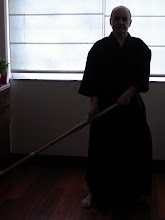Taken from: http://kenshi247.net/blog/2011/11/30/kamae-equation/
The importance of developing a good kamae is stressed by every kendo instructor that you meet: without a correct kamae, many sensei state categorically, you cannot do correct kendo. Only once your kamae is correct can this lead to execution of correct technique (and thus “beautiful” kendo). It naturally follows, then, that a kamae that is flawed can only lead to flawed strikes, even if the execution is fast and strong.
But what is a correct kamae?
Although I could easily show you a diagram of the definition of a “correct” kamae, the fact of the matter is that individuals develop their own kamae based on their own body characteristics through years of experience. The length of peoples arms and legs, their height and frame, the length of their trunk in comparison to their legs, etc etc, all these parameters are part of what I will call the kamae-equation.
As an individuals kendo career advances, they undoubtedly change their kamae many times. This is a natural part of kendo growth and teachers should not only encourage their advanced students to think deeply about their kamae, but be considerate of individuals physical differences. We should also be aware of physical changes that occur over time and there impact on an individuals kendo. For beginners or less-experienced students, however, its best to try to fix their kamae into a single style until they get more experienced.
The following will not attempt to explain or expand on the above in full, but simply look at a single difference that can be explored when studying kamae. Its up to you as an individual to research further.
Chudan-no-kamae
Walking into a dojo today, each sensei has their own (based on experience) kendo style including, naturally, their own kamae. Even though this is the case, we can say that, very broadly, chudan-no-kamae falls into one of two main – and equally acceptable – types:
* Straight kamae (chudan-no-kamae)
As you can see by looking at the first 2 sensei in the picture above, their body is straight on, hips are square, and the shinai/sword is pointing directly straight. This style is universally taught to children and beginners, and is the way you must kamae in kendo-no-kata. This is by far the most common way to kamae for the general kenshi.
* Open kamae (seigan-no-kamae)
Looking at the last 2 sensei in the picture above you can easily see that their body is slightly open to the left (hips are diagonal, left foot is sometimes slightly splayed), their left fist is moved to the left, and their shinai is pointing to the right. This is very common kamae seen in elder and/or more experienced kenshi in Japan (I sometimes see it in very good high-school and university level kenshi as well). This is almost probably the more classical or orthodox shape of what we refer to as “chudan” nowadays.
Although I referred to this open kamae as “seigan-no-kamae” above, this nomenclature has fallen out of general use in recent years (or is sometimes used to describe the shape taken when facing a jodan kenshi*). In fact, either of these kamae can correctly be called ‘chudan.’
* this is sometimes called ‘kasumi(-no-kamae)’ but this branding is, it seems, a product of internet forums.
Chudan type vs center line
Commonly the ‘center’ is usually taken to be the line of extension from your kensen to (usually) the vertical line from your opponents forehead down to their stomach/abdomen. ‘Semeai’ is the battle to see who can control this line and, by extension, be in the best position to execute a successful strike. This works fine for the general chudan described above, but for seigan the extension of the kensen tends to be from the opponents left eye, down the left side of their body to their stomach/abdomen. It naturally follows that semeai will be slightly different in this state.
Another often heard explanation is that the ‘center’ is not a line, but a (sometimes triangular) ‘zone’ in which you can freely move your kensen in order to pressure your opponent.
Either way, the ‘center’ is generally a nebulous thing, with a strong psychological element as well as physical aspect attached, the understanding of which only comes after years of training (not that I understand it of-course!!).
Chudan vs Seigan
As a teacher of kendo who is still very much first and foremost a student himself it is, I believe, worthwhile thinking about who uses which type of kamae and why, and which shape leads to easier use of what waza. Not just that, however, I also believe its important to consider your own and your students kendo in total (e.g. age, experience, body type, etc) when it comes to studying kamae and what springs from it (seme(ai) and the execution of techniques, etc). In this way you can develop a correct kamae that fits the individual, and by extension bringing yourself and them closer to our goal of correct and (thus) beautiful kendo.
Summary?
Although this small article is called kamae-quation I didn’t expand the description on that part on purpose. I also chose not to talk about other elements that spring up from the description on chudan types, for example the difference in semai. This to was done on purpose. Japanese kendo manuals are replete with the terms “kenkyu” and ‘kufu” (to research, study, and work things out by yourself), i.e. the final responsibility for the kendo that we do is ourselves. In that way, I offer no summary here, just (maybe) pause for thought.
Mi sello, mi glifo, mi camino
Hace 4 meses






No hay comentarios:
Publicar un comentario